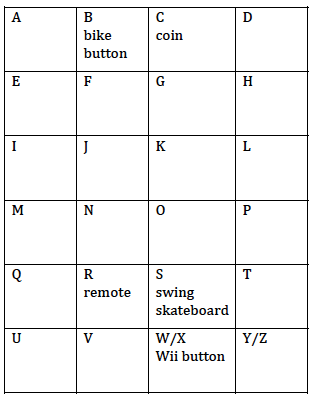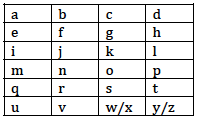Let's Use Force
Summary
The students will be able to: explain how a push or pull affects how an object moves, the difference of a push and pull, and the way to change how something is moving is to give it a push or a pull.
Materials
- Book, Duck in the Truck, by Jez Alborough
- Whiteboard
- Whiteboard marker
- Permanent marker
- Highlighter
- Two demonstration size (approx. 24" by 36") white papers for alphaboxes
Books:
- Duck in the Truck, by Jez Alborough; ISBN: 0‐06‐443833‐3
- Push and Pull, by Robin Nelson; ISBN: 978‐0822552994
- Forces Make Things Move, by Kimberley Brubaker Bradley, ISBN: 978‐0064452144
- And Everyone Shouted, "Pull! : A First Look at Forces and Motion, by Claire Llewellyn; ISBN: 978‐1404806566
- Cucumber Soup, by Vickie Leigh Krudwig; ISBN: 978‐1555913809
- Big Pumpkin, by Erica Silverman; ISBN: 0‐590‐47760‐9
- The Teeter‐Totter, by Joy Cowley; ISBN: 1‐56270‐732‐9
- Push and Pull (Rookie Read‐About Science) by Patricia J. Murphy; ISBN: 978‐051628644
- Push and Pull (Yellow Umbrella Books: Science ‐ Level A), by Hollie J. Endres; ISBN: 978‐ 0736828802
- You Read to Me, I'll Read to You, by Mary Ann Hoberman; ISBN: 978‐0316013161
Background for Teachers
We exert force to move things. Children may be unaware that this force affects the motion of the object. Force has a direction. This direction can be back and forth, straight, circular, zigzag, curved, and fast or slow. Pushing or pulling can affect how an object moves. Children need to be made aware of this before you begin instruction.
Intended Learning Outcomes
1. Demonstrate a positive learning attitude.
5. Understand and use basic concepts and skills.
6. Communicate clearly in oral, artistic, written, and nonverbal form.
Instructional Procedures
Attachments
Content Connections:
Literacy ‐ The teacher can select books for read alouds and browsing books that have force and motion in the story. Have children write stories with a focus on pushing and/or pulling. Mathematics--Ask children to make observations of pushes and pulls at home and then report back what they observed. The teacher collects the data, and then the class graphs their observations of pushes and/or pulls.
Invitation to Learn:
Ask the children, "What is a push?" and listen carefully to their answers. Ask the children, "What is a pull?" and listen carefully to their answers. After a brief discussion of pushes and pulls, tell them that pushes and pulls are a means by which they use force to move something. Depending on the children you may want to record on a whiteboard the items they mention for pushes and pulls. Engage the children in a discussion of how much force it takes to move, for example, a tennis ball, soccer ball, or a bowling bowl.
Instructional Procedures:
Read the book, Duck in the Truck. After reading the book, lead the children in a discussion of the story. Remembering to focus on push/pull. If you have recorded on a whiteboard items that can be pushed and/or pulled, add any new items the children may now suggest.
Ask the children to look around the classroom for something that they might push or pull. Depending on time, allow the children to demonstrate a push or pull.
Have the children use their arms, feet, and legs to push themselves off of the floor and stand. Have them pull their stomach muscles in and stand tall as they push their arms ten times into the air as if they were raising the ceiling.
Prepare two large alphaboxes for "Is It a Push or a Pull?" Chart paper or white butcher paper can be used (approximate size is 24 inches by 36 inches). Example:
- Tell the children to think about what can be pushed?
- Tell them that as they tell you names of things that can be pushed, you will write
down the name in the alphabox with the same beginning letter as the thing
mentioned.
Example of "push: alphaboxes:

- Depending on the availability of time, you may want to do the "pull: alphaboxes on another day.
- After the children seem to run out of ideas, stop and tell them that during the day (possibly during literacy center time) they are to reread the "push" alphaboxes chart and then read one of the push/pull books in the center.
- If they can think of a new object, they are to write it down in the appropriate box. I suggest having them write the words in a different color marker to make it easier to find their added words on the chart.
- Find a time when the whole class can read the newly added words in the alphaboxes together as a group and discuss them.
- Be sure to do the "pull" alphaboxes.
- At a later time, read the alphaboxes for "push" and highlight words that can also be a "pull."
- Do the same for the alphaboxes for "pull."
Lesson and Activity Time Schedule:
- Reading the book and starting the alphaboxes will take approximately 55 minutes.
- The readers' theater will take approximately 20 minutes.
- Comparing the push alphaboxes to the pull alphaboxes will take 10 to 15 minutes.
Activity Connected to Lesson:
Perform the readers' theater Stuck in the Mud.
Have the children sit on the floor or at their desks. Pass out copies of Stuck in the Mud (pdf) to each student. Divide the class into two groups to read the readers' theater. Decide which group reads the right column of text and which reads the left column. Everyone reads the words in the middle of the readers' theater.
You may want to go over any words that you believe will be difficult for your children. Read the readers' theater Stuck in the Mud a few times. In the classroom, children can practice Stuck in the Mud in guided reading groups, with a parent volunteer, a reading buddy, and as a whole class. Practice it for a couple of days and then send it home for the children to read with their family.
Children may also perform the readers' theater for another class, principal, and/or media aides.
Activity Materials:
- Copy of Stuck in the Mud (pdf) for each child
Extensions
Attachments
- Have the children sort real items by whether it is pushed, pulled, or both.
- Have the children sort pictures by whether they are pushed, pulled, or both.
- Have a variety of books that have a focus on pushes and pulls available for the children to read.
- Look for guided reading books in your school's leveled library for use in small group instruction.
- Choose books for your read‐alouds that have a focus on pushes and pulls.
Family Connections:
At home, have the children observe how their family pushes or pulls things. Then have them write or draw the examples of what they see pushed or pulled. These papers (pdf) should be returned to school for a class discussion.
Also, have them search for something they would like to bring to school to show a push or a pull. Be sure to have them write their name on their object.
Assessment Plan
- Have children identify and/or demonstrate a push and a pull.
- Have them sort real items and/or pictures and explain why they sorted the way they did.
- Ask students to write about push and pull in a narrative story or as informational text.
Updated: 02/17/2022


 UTAH EDUCATION NETWORK
UTAH EDUCATION NETWORK

 Justin
Justin Braxton
Braxton Dani
Dani Kayla
Kayla Katie
Katie Matthew
Matthew Rob
Rob Val
Val

